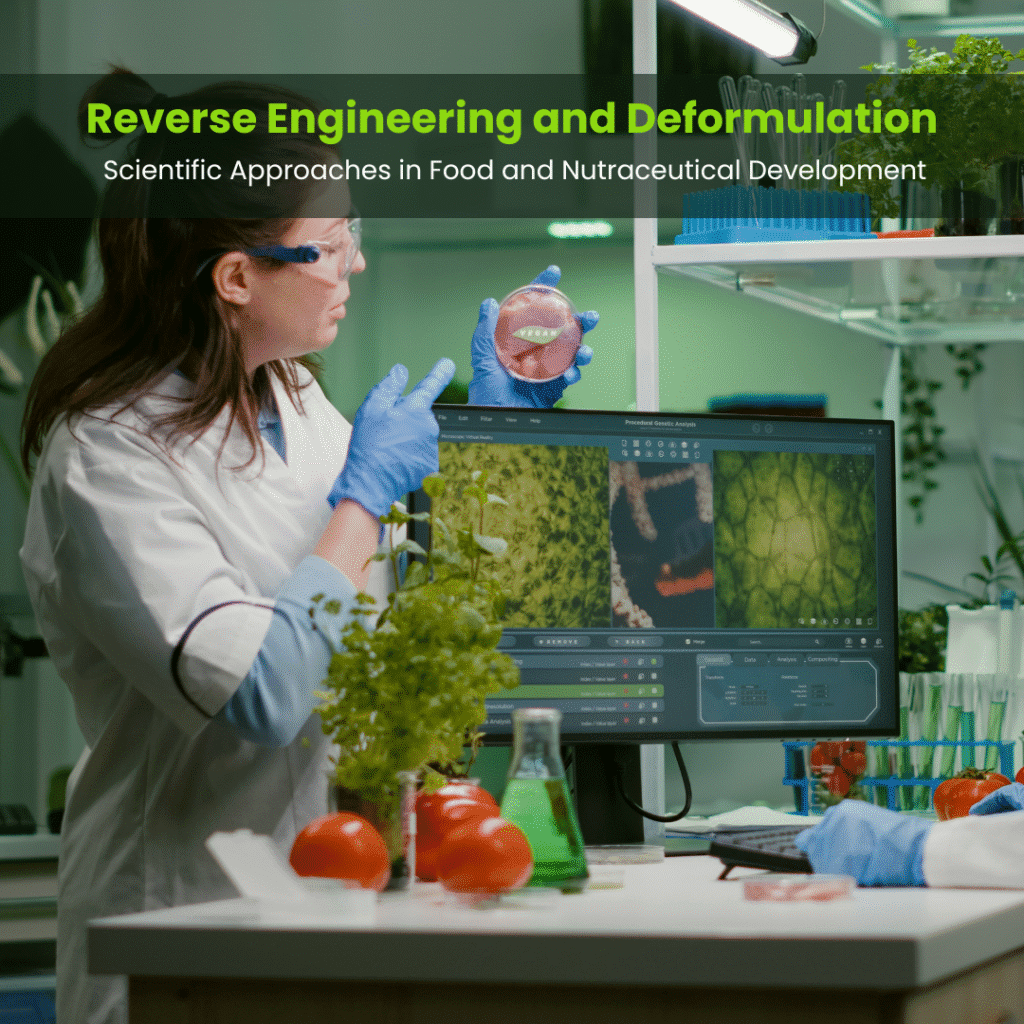Reverse engineering and deformulation are sophisticated alliances to know the content, structure and function of a finished product in food, beverage, nutraceutical, and herbaceutical industries. Reverse engineering and deformulation are necessary when the product require replication, improvement, confirmation of competitor analysis, and/or verification of compliance with regulations. More than just ingredient breakdown, reverse engineering and deformulation is not merely raw data; it uses scientific instrumentation and methodologies to expose both the known and unknown of the product. [1]
Scientific Approaches in Food and Nutraceutical Development
Reverse engineering and deformulation are sophisticated alliances to know the content, structure and function of a finished product in food, beverage, nutraceutical, and herbaceutical industries. Reverse engineering and deformulation are necessary when the product require replication, improvement, confirmation of competitor analysis, and/or verification of compliance with regulations. More than just ingredient breakdown, reverse engineering and deformulation is not merely raw data; it uses scientific instrumentation and methodologies to expose both the known and unknown of the product. [1]
Importance of Reverse Engineering and Deformulation
Reverse engineering and deformulation practically has considerable strategic and technical uses:
- Competitor Assessment – Competitor product elements that are industry best practice is identified permitting product insights into materials, processes, and possible cost savings.
- Formulation Assurance – It could unearth current formulation hazards, help navigate the unknown to illustrate ongoing performance, stability, and taste; thus, helping to develop ideal product.
- Compliance – It can identify non-compliant or banned substances; ensure an acceptable alignment to food, beverage, safety, and labeling regulations adopted across the globe.
- Innovation – It can assist R&D development of a better or cleaner label product(s) if there is understanding of what works within a existing market product(s).
- Troubleshooting Gap Analysis – It provides data driven solutions that can shore up quality faults arising from raw ingredient supplier discharge quality; contaminates and/or process errors. [2]
Table 1: Use-Case Mapping of Reverse Engineering and Deformulation in Nutraceuticals
Use Case | Purpose | Example |
Competitor Assessment | Understand competitor formulation | Compare leading protein shake formulations |
Formulation Assurance | Detect performance issues in current products | Identify instability in an herbal syrup |
Regulatory Compliance | Check for banned or mislabelled substances | Detect artificial sweetener banned by FSSAI |
Innovation | Improve existing products or develop cleaner labels | Replace synthetic emulsifier with lecithin |
Troubleshooting/Gap | Investigate faults in quality | Identify microbial growth due to high Aw |
Key Concepts
Reverse Engineering
Reverse engineering is the scientific process of taking apart a product to determine how it was formulated. In the food and nutraceutical realm, reverse engineering consists of inspecting:
- The ingredient makeup (declared and undeclared)
- The processing methods (construction)
- The physicochemical properties finished (moisture, texture, phenomena, viscosity)
- Sensory attributes and how sensory attributes relate to function of the ingredients [3]

Deformulation
Deformulation is a subset of reverse engineering that has the intent of identifying and quantifying all the separate components in a formulation. This includes:
- Macronutrients: proteins, fat, carbohydrates, fibres
- Micronutrients: vitamins, minerals
- Additives: preservatives, colourants, stabilizers, emulsifiers
- Functional ingredients: botanicals, bioactives, enzymes, probiotics
- Excipients and carriers which are common in supplements and functional foods [4]
Table 2: Ingredient Categories and Their Analytical Focus in Deformulation
Ingredient Type | Examples | Why Important |
Macronutrients | Proteins, fats, carbs | Nutritional profiling and claim substantiation |
Micronutrients | Vitamin D, Iron, Zinc | Label claims, regulatory compliance |
Additives | Sorbates, Tartrazine | Safety and clean-label verification |
Functional Ingredients | Probiotics, botanicals, enzymes | Product differentiation, functional claims |
Excipients/Carriers | Maltodextrin, cellulose derivatives | Dosage form stability and delivery efficiency |
Analytical Techniques Employed
Analytical Techniques Employed
- Physical Testing
- Texture Analysis: evaluates firmness, chewiness and mechanical properties
- Colorimetery: measures the colour for quality and consistency
- PH and Water Activity: these are tested to determine shelf-life and microbial stability
- Chemical Analysis
- Macronutrient Profiling: Standard wet chemistry (AOAC) methods
- Micronutrient Quantification: By UV-visible spectrophotometry and atomic absorption spectrophotometry (AAS),
- Preservatives and Additive Detection: Using HPLC, GC and TLC methods
- Instrumental Analysis
- GC-MS (Gas Chromatography-Mass Spectrometry): detects volatile and semi-volatile compounds
- HPLC (High-Performance Liquid Chromatography): the ideal method for separating non-volatile components such as poly phenols and vitamins
- FTIR (Fourier Transform Infrared Spectroscopy): gives functional groups and fingerprinting of complex matrices
- NMR (Nuclear Magnetic Resonance): good for structural elucidation of organic compounds. [5]
Table 3: Analytical Techniques and Their Application in Nutraceutical Deformulation
Technique | Purpose | Applicable To |
Texture Analyzer | Assess chewiness, firmness | Snack bars, gummies |
UV-Vis/Atomic Absorption | Quantify micronutrients | Fortified beverages, powders |
HPLC | Detect preservatives, bioactives | Functional drinks, capsules |
GC-MS | Identify flavor volatiles, essential oils | Herbal syrups, ayurvedic products |
FTIR/NMR | Structural fingerprinting | Complex herbal formulations |
Step-by-Step Process of Reverse Engineering and Deformulation
- Sample Collection: Acquire representative samples of the product(s) to be analyzed including any market variants or samples from individual size batches.
- Objective Identification: Be very clear about the objectives – Are you replicating, benchmarking a product, improving quality, or seeking compliance with regulations?
- Preliminary Assessment: Conduct bench-top visual inspection, a label review, and initial sensory assessment followed by preliminary suggestions about possible ingredients and processes.
- Physical and Sensory Testing: Measure physical parameters that describe texture, color, viscosity, and other aspects of the product that can be assessed.
- Chemical Profiling: Using standard methods quantify and qualify the ingredients.
- Advanced Instrumentation: Run GC-MS, HPLC and FTIR to accurately identify components.
- Data Integration and Interpretation: Compare obtained results against known standards, industry benchmarks, and regulatory lists.
- Reporting: Provide a scientific report detailing findings with interpretations, identified product choices, recommendations for further product development and optimization. [6]
Example – Case Study – Deformulation of an Herbal Digestive Syrup for Compliance to Regulatory Stability and Labeling Requirements
Objective: To benchmark then improve taste from a competing product.
- Initial assessment showed ayurvedic claims and no preservatives listed
- Texture analysis indicated thick viscosity and separation after 7 days
- GC-MS analysis confirmed the presence of sorbic acid (preservative not listed)
- The sylvanie was reformulated to include natural preservatives and better emulsifiers
Outcome: Better taste, compliant label, shelf life extended.
Applications of Reverse Engineering and Deformulation
Product Replication
Deformulation provides you with the insight into the formulation, from its individual ingredients to the manufacturing process itself. As a result, you can reproduce successful formulations, for example, in private label, own-brand equivalents, or product line extensions.
Competitor Benchmarking
Deformulation provides nutritional, functional, and sensory data, so that you can evaluate competitive products and base your differentiating product positioning on data.
Ingredient Substitution
You can also determine problematic ingredients – allergens, artificial additives, expensive components – and suggest suitable substitutes, which allows for cleaner-label and lower-cost formulations.
Quality Control
When things go wrong – such as off-flavors; separation; sedimentation, or shelf-live; deformulation can identify the problems at an ingredient or process-level.
Regulatory Compliance
Deformulation can detect banned or restricted substances and checking whether ingredient labels are accurate (i.e.: ingredient mislabeling). This can assist in meeting regulatory obligations for food safety authorities such as FSSAI, FDA, EFSA etc.
Batch Variation Management
Deformulating a product on a periodic basis can monitor ingredient variability or supplier inconsistency on an ingredient, which promotes batch-to-batch consistency. [7]
Limitations and Ethical Considerations
While reverse engineering and deformulation provide valuable information, they each have limitations and obligations:
- Patented Formulations: Copying protected intellectual property is illegal. This means that while analytical results will provide the information necessary to formulate, you may not violate any patent claims.
- Complex Matrix Challenges: Highly processed goods or emulsified products will hinder separation and analysis.
- Confidentiality Obligations: Deformulation results are confidential and must be treated ethically, especially if they relate to competitor products.
- Accuracy Constraints: Components could be at trace amounts below detection or integrated with little to no separation due to interaction effects.
Industry Sectors Benefiting from These Services
- Functional Foods and Beverages: Protein shakes, fortified juices, low-GI snacks
- Nutraceuticals: Tablets, capsules, powders, gummies
- Herbaceuticals: Herbal infusions, syrups, Ayurvedic blends
- Cosmeceuticals: Nutricosmetic drinks, beauty-from-within supplements
- Over the Counter (OTC) Products: Digestive aids, energy boosters, immunity boosters [8]
Table 4: Sector-Specific Use Cases for Reverse Engineering and Deformulation
Sector | Application | Example |
Functional Foods | Clean-label snack formulation | Replace maltodextrin with date powder |
Nutraceuticals | Improve tablet disintegration | Identify excipients with higher solubility |
Herbaceuticals | Identify undisclosed ingredients | Detect synthetic color in an ayurvedic tea |
Cosmeceuticals | Sensory benchmarking | Match texture of competitor collagen drink |
OTC Products | Ingredient mislabeling verification | Detect caffeine in a claimed non-stimulant |
We have the experience, knowledge and ingredients portfolio to help you develop
Interested in learn more? Get in touch, we’d love to discuss your next project with you
Conclusion
Reverse engineering and deformulation services are valuable components of the current food and nutraceutical development process, providing manufacturers and product developers with quantitative scientific data for strategic decision-making in formulation, innovation, and quality management. Whether it’s benchmarking a reference example, improving an established formulation or circumventing a quality challenge, reverse engineering and deformulation services provide a systematic and ethical approach to market-ready innovation.
In an increasingly regulated and progress-driven marketplace, reverse engineering and deformulation services apply scientific rigour and advanced instrumentation to uncover the epistemology behind complex formulations, laying the groundwork for competitive and compliant product development.
Ready to Develop Your Next Market-Ready Product?
Whether you’re aiming to replicate, enhance, or troubleshoot your product, our reverse engineering and deformulation services provide the scientific foundation for intelligent product development. Contact FRL today to learn more about reverse engineering.

Let’s create something Innovative and Delicious together
Food Research Lab strives for excellence in new Food, Beverage and Nutraceutical Product Research and Development by offering cutting edge scientific analysis and expertise.




